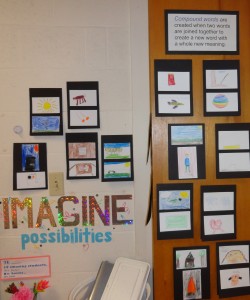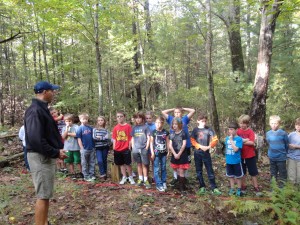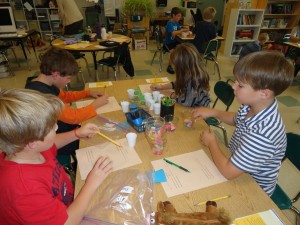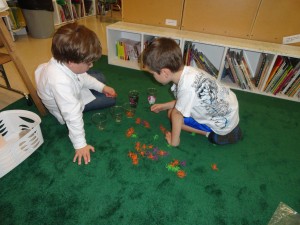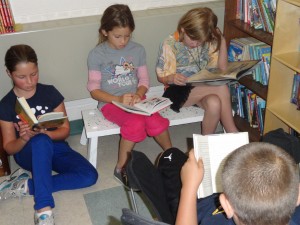 It has been nice to have a week that seems back to normal and with our usual routine. Thank you again for all your support in helping the children explore the history of North Hampton and our world through the homework collections. 1912 was an interesting time. We have been looking at pictures and collecting artifacts. It is challenging to think of how thing were way back then. We will be using all this information to generate timelines helping us consider changes through history.
It has been nice to have a week that seems back to normal and with our usual routine. Thank you again for all your support in helping the children explore the history of North Hampton and our world through the homework collections. 1912 was an interesting time. We have been looking at pictures and collecting artifacts. It is challenging to think of how thing were way back then. We will be using all this information to generate timelines helping us consider changes through history.
Showing Respect in Both Big and Small Ways
This week we expanded on our conversation about respect. A wide variety of books help us think of how even the smallest things we do may matter. Not smiling back at a person we don’t know well, only sitting with certain friends or always leaving papers out at our workspaces are acts of kindness and show respect (or not) to others. Small acts can add up and they can leave others bewildered. Not taking the time to say excuse me or I’m sorry for small bumps or interruptions can matter. The book Each Kindness reminds us that sometimes we don’t have the opportunity to make things right. It doesn’t feel good to be ashamed of what you’ve done.
We talked about why we treat people differently. We treat people differently according to how well we know them. We also treat people differently according to our moods or they way we feel in different situations. We all agreed we could not be perfect, but we could work to make sure other people around us felt safe and noticed. We are going to think about being careful when we walk by the preschool and kindergartens. We are going to try to be quieter as we go by the first grades. They are trying to work after our lunch when we go by. Little things matter and we are going to try to pay attention to them.
Learning More About Our World
We have begun reading books and poems and sharing songs about the world, geography and mapping. This has fit in nicely when thinking about differences. We think that people everywhere have the same basic needs – how we get them looks differently according to where we live. It is interesting to learn more about the differences across the world as we study geography.
It is also interesting to learn more about the changes in the world and North Hampton as we explore history. We gained understanding and information from the illustrations in Mailing May and Wonder Horse. They helped us know about lighting, everyday clothes and interests. We know those are both true stories from the early 1900’s and they helped us notice some details about that time we hadn’t thought about, and also to wonder more about daily life. How was it different in towns and cities? What was a lot of money then? Did people travel or did they stay in one place most of the time?
The Seven Wonders of Sassafras Springs
This week we began reading another book by Betty Birney – she also writes the Humphrey series. This week we finished Mysteries According to Humphrey and many of the children have read other books from that collection. Sassafras Springs is a rural town in the middle of Missouri. Eben, the main character, finds it terribly ordinary. He longs to travel and wishes to see something amazing like the Seven Wonders of the World. His dad challenges him to take notice of his town and tell him if he can find seven wonders in seven days he’ll send him on the train to Colorado to see snowy peaked mountains and the cousins he’s not met. And so the search begins…
We are going to use this as a springboard text to launch our own exploration of North Hampton. We’ll soon be searching for wonders as well and helping the children understand how their town’s history and cultural heritage shape they way we live today. Hopefully the children will start looking and noticing the wonders that are around them.
Bits and Pieces –
- We have begun to explore contractions. We are working to think about them and make sure we use them properly and spell them well.
- We are exploring the meaning of “detail.” How do you define it and how can actually identify them? The children know they are good. In writing they add interest and excitement. Details convey emotion and feeling in writing. They set the tone of the piece. But what are they and how will we know the difference between using enough and using too many.
- This week as we worked with The Numbers of the Week we used base-10 blocks to create a model of 37,416. We are beginning to understand amounts in the thousands and how they work. We also have the first glimmers of understanding of how rounding off and estimation can help us become more accurate in our exact calculations.

- We are beginning to practice two Readers’ Theater Play with Mrs. Sherouse. We will perform them at Barnes and Noble in Newington in early December. (exact date to follow)
- We have an Outdoor Challenge on Tuesday – the children may need to warm clothes it we are on the Nature Trail. Check the weather. Thanks.
Each time we finish a chapter read aloud we do a little project as a celebration of our reading accomplishment together. This time we made cards for Humphrey similar to the card he made for Mrs. Brisbane when she was missing. They are hanging on a mobile in our room. Here are some of our cards and messages. Humphrey is an “unsqueakably” great classroom pet!
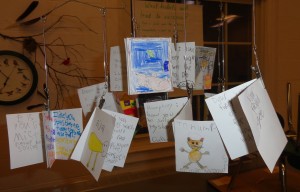

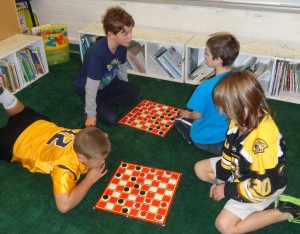

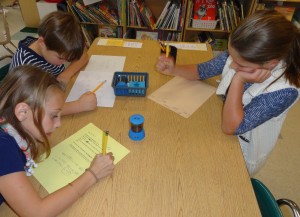
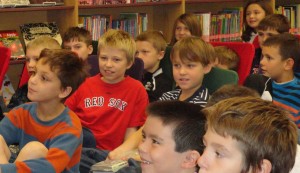
 Here are some of the thoughts the class had when Steve Cotler, author of the Cheesie Mack series came to North Hampton School yesterday.
Here are some of the thoughts the class had when Steve Cotler, author of the Cheesie Mack series came to North Hampton School yesterday.



